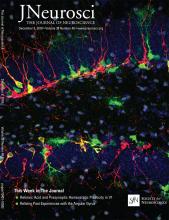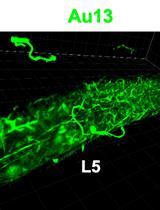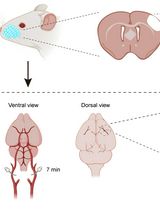- EN - English
- CN - 中文
Assessing Olfaction Using Ultrasonic Vocalization Recordings in Mouse Pups with a Sono-olfactometer
使用超声波嗅觉计通过超声波发生记录评估小鼠幼崽的嗅觉
(*contributed equally to this work) 发布: 2019年02月20日第9卷第4期 DOI: 10.21769/BioProtoc.3170 浏览次数: 6637
评审: Geoffrey C. Y. LauJie LiAndrew L. Eagle

相关实验方案
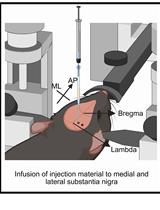
基于 rAAV-α-Syn 与 α-Syn 预成纤维共同构建的帕金森病一体化小鼠模型
Santhosh Kumar Subramanya [...] Poonam Thakur
2025年12月05日 1402 阅读
Abstract
Olfaction is the first sensory modality to develop during fetal life in mammals, and plays a key role in the various behaviors of neonates such as feeding and social interaction. Odorant cues (i.e., mother or predator scents) can trigger potentiation or inhibition of ultrasonic vocalizations (USV) emitted by pups following their isolation. Here, we report how USV are inhibited by olfactory cues using a sono-olfactometer that has been designed to quantify precisely olfaction in pups congenitally infected by cytomegalovirus. This olfactory-driven behavioral test assesses the USV emitted in presence of unfamiliar odorants such as citral scent or adult male mouse scent. We measure the number of USV emitted as an index of odorant detection during the three periods of the 5-min isolation time of the pup into the sono-olfactometer: first period without any odorant, second period with odorant exposure and last period with exhaust odorant. This protocol can be easily used to reveal olfactory deficits in pups with altered olfactory system due to toxic lesions or infectious diseases.
Keywords: Olfactory signals (嗅觉信号)Background
In mammals, olfaction is the first sensory sense to become functional in utero, long before audition and vision (Stickrod et al., 1982; Sarnat and Yu, 2016). Survival and growth of neonates depend on the mother and rely heavily on their reciprocal olfactory-driven behaviors such as nipple localization, feeding, attachment, predator avoidance, etc. (Teicher and Blass, 1976; Brunjes and Alberts, 1979; Bell and Smotherman, 1980; Brouette-Lahlou et al., 1992; Shair et al., 1999; Hongo et al., 2000; Perry et al., 2016; Al Aïn et al., 2017). Thus, congenital or perinatal impairment of the sense of smell, such as toxic or infectious injury of the olfactory system, could have profound health concerns. While a great number of non-operant and operant behavioral tests are available for assessing the sense of smell in adult rodents (Bodyak and Slotnick, 1989; Slotnick and Restrepo, 2005; Kobayakawa et al., 2007; Yang and Crawley, 2009), there is a serious limitation in exploring olfaction in very young rodents due to their limited behavioral repertoire. Nevertheless, a suitable test to address odor perception in rodent pups has been designed based on the recording of ultrasonic isolation calls (Hofer and Shair, 1991; Hofer et al., 2002; Lemasson et al., 2005; Lazarini et al., 2018). Young pups, while isolated from the mother and littermates and placed in low ambient temperature produce ultrasonic vocalizations (USV) at a high rate (Smith and Sales, 1980; Branchi et al., 1998; Castellucci et al., 2018), that promote maternal behavior such as searching for pups, retrieving and licking of pups (Noirot, 1974; Brounette-Lahlou et al., 1992; Brunelli et al., 1994). Infants of most mammals, including humans, also emit repeated vocalizations in the audible range after isolation, as a distress signal aiming at eliciting maternal behavior. USV emission of the isolated rodent pups stops at the contact of the mother, littermates or nest odor (Szentgyörgyi et al., 2008). On the one hand, potentiation of the USV response to isolation can be induced by exposition to the scent of its mother or another lactating female (Shair et al., 1999). On the other hand, inhibition of the ultrasonic calls could be induced by exposition to the scent of an unfamiliar adult male, one of its common predators in the wild (Shair et al., 1999). USV inhibition can also be achieved by exposure to a non-social odorant cue, such as citral, that triggers innate aversive response (Lemasson et al., 2005). Using this olfactory-induced USV inhibition, we found that congenital cytomegalovirus (CMV) infection alters olfaction as early as Day 6 after birth, long before hearing deterioration in mice (Lazarini et al., 2018).
The current protocol describes a method for assessing odor perception in young mouse pups soon after birth, using a custom-made sono-olfactometer. Because this approach has been developed in the context of congenital viral infection, the sono-olfactometer was designed to prevent any spread of the virus from infected pups to the environment. It can be used therefore in Biosafety level 1 (BSL-1), level 2 (BSL-2) or level 3 (BSL-3) according to the microbial status of the manipulated animals. This characteristic was made possible by slightly modifying the earlier version of our olfactometers (Lemasson et al., 2005). The pup chamber of the sono-olfactometer constitutes a mini-isolator in which odorants can be presented at a constant concentration and then efficiently exhausted. This sono-olfactometer allows simultaneous exposition to various odorants and recordings of USV emitted by the pup placed in the chamber. This protocol can be easily expanded to explore olfaction in other paradigms of acute and chronic injury or infectious diseases in the olfactory system of wild-type or genetically-modified rodents.
Materials and Reagents
- 50-ml tube (Corning, France, catalog number: 430828) with two custom-made 5 mm-diameter holes in the lid
- Laboratory-bred mouse pups from 6-8 days after birth
Notes:- Put in a single cage each pregnant female one week before the timed day of birth.
- For the test, male and female pups can be used. We only tested Oncins France 1 (OF1) mouse line from Charles Rivers, France with this behavioral protocol. This mouse strain is productive and widely used for teratology. Pups of other mouse strains such as C57Bl/6J emit similar USV (Castellucci et al., 2018).
- Infected-pups can be used as previously described (Lazarini et al., 2018). OF1 mother mice and its litter from Charles Rivers, France were individually housed in two isolators, one for the control (CTL) group and the second for the CMV group, kept in a BSL-2 room with controlled temperature (22 °C) and humidity (range: 40%-70%), under 12 h light/dark cycle (lights on at 8:00 AM) in the Pasteur Institute animal facilities accredited by the French Ministry of Agriculture for performing experiments on live rodents. Mice were manipulated in class II safety cabinets.
- You can identify the pups at Day 1 after birth using long-lasting paw tattoos, subcutaneously injected with a 0.3 mm x 13 mm needle.
- Male scent (10 g soiled bedding from a group of 6 unfamiliar male adult OF1 mice)
- Mineral oil (Sigma, France catalog number: M5904)
- Citral (Sigma, France catalog number: W230316)
Note: Citral has lemon scent. - 70% Ethanol solution
- Citral solution (see Recipes)
Equipment
- Class II safety cabinets
- Custom-made sono-olfactometer (depicted in Figure 1)
- The audio recording system is composed of:
- A sound card recorder (PreSonus AudioBox iTwo) (Figure 1). The sound card can be replaced by any other commercial model. The recording potentiometer is adjusted to maximize the signal-to-noise ratio and avoid overloading.
- A heterodyne bat detector (whose microphone has been moved into the chamber isolator using a BNC cable) (Magenta Bat5 Digital Bat Detector, RSPB, UK) (Figures 1 and 2). The heterodyne bat detector is set to the center frequency of the mouse vocalization: The volume control of the bat detector is adjusted in the middle to avoid background noise.
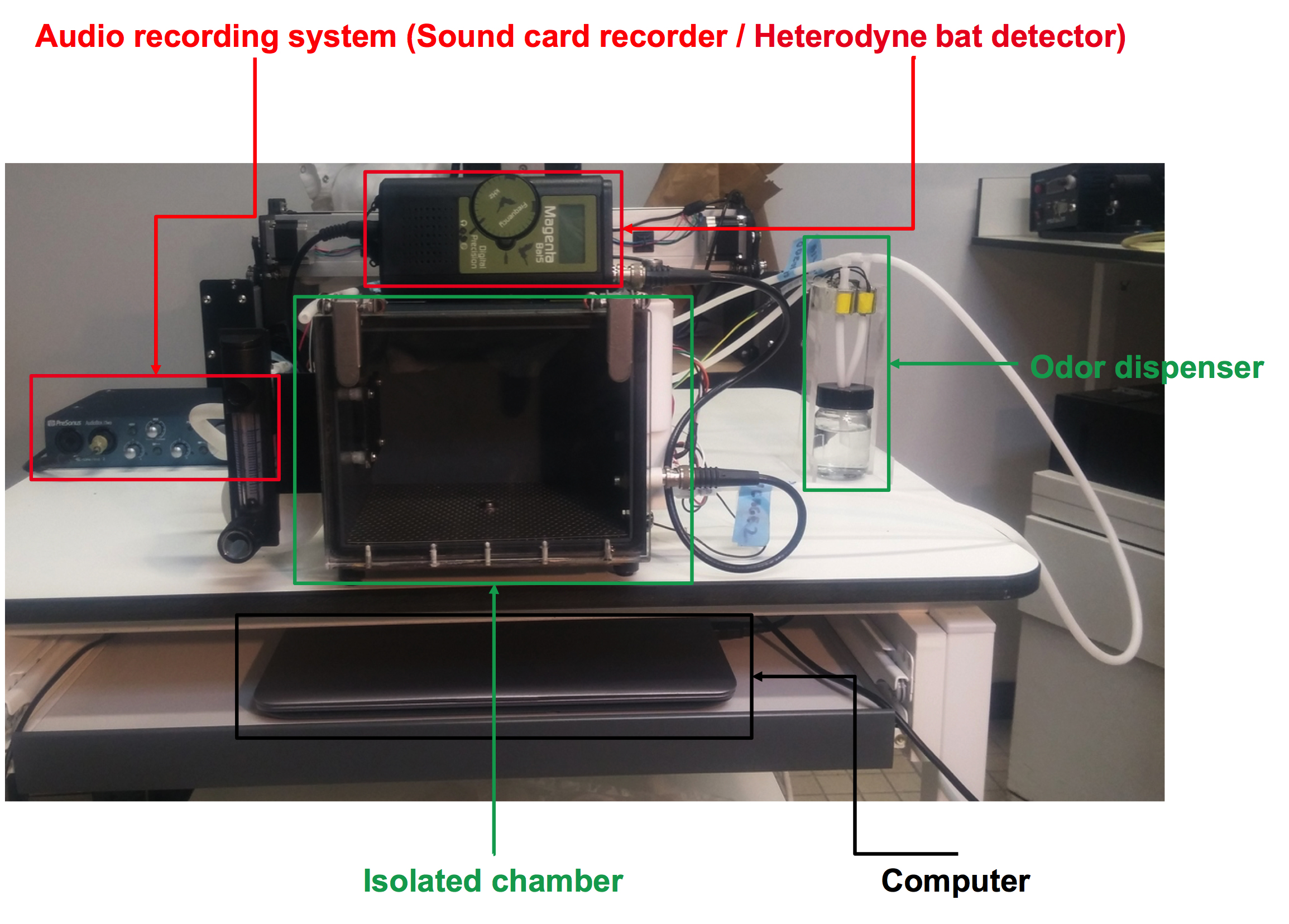
Figure 1. The sono-olfactometer. The sono-olfactometer is a system that delivers odors while recording the ultrasound emitted by mice. It is composed of four sub-systems: 1) An audio recording system; 2) Two identical isolated chambers (only one chamber will be presented); 3) An odor dispenser (olfactometer); 4) A computer with its own software. - The isolated chamber (Figure 2):
- Exhaust air pump (Schego, catalog number: 850)
- Non-return (check) valve (composed of two elements from Colder Products, catalog numbers: PLCD220-04 and PLCD10004)
- Exhaust air flow meter (Brooks Instrument, catalog number: FR2A13BVBN)
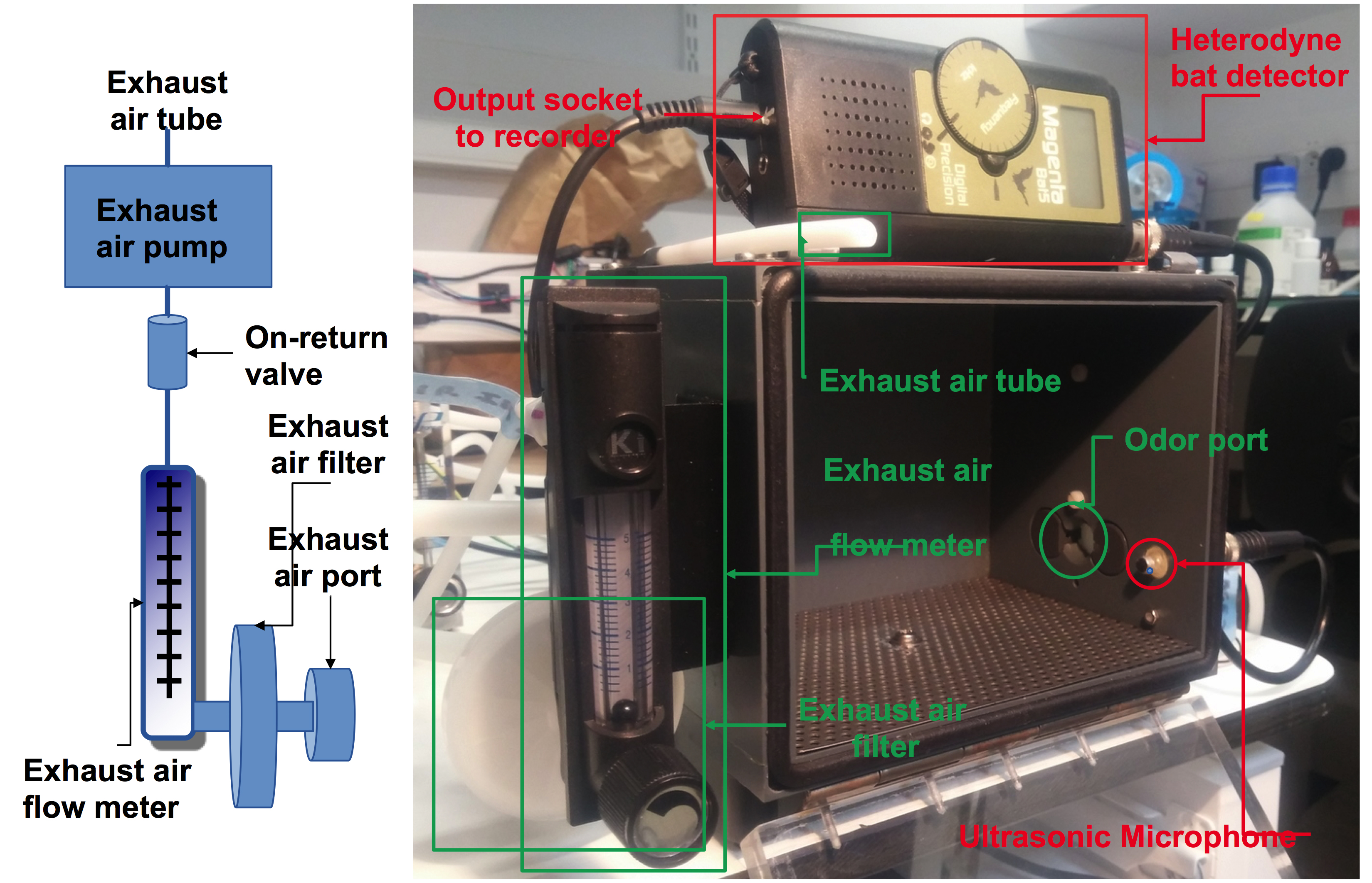
Figure 2. The isolated chamber. The isolated chamber (inside size 18 x 12 x 12 cm) is sealed and airtight when closed. The isolated chamber was made with components (8 mm-thick black PVC walls for the ceiling, the floor and sides, 8 mm-thick transparent plexiglass for the door, 5 mm-diameter rubber seal for the door, 0.1 mm-thick aluminum coating plate with 2 mm diameter holes) easily available in DIY stores such as Lacrylic shop, Bonneuil sur Marne, France. The odor port and the ultrasonic microphone are on the right side of the chamber. The odor dispenser releases the Odor/Air mixture in a controlled manner through the odor port (Figure 3). A drain hole in the center of the left side is connected to a HEPA exhaust air filter (Millex-FG, 0.20 µm, PTFE hydrophobe, 50 mm). The air is evacuated by an exhaust air pump, a non-return (check) valve (composed of two elements from Colder Products, and an exhaust air flow meter (Figure 3), thus avoiding microbial contamination of the environment. The exhaust air containing odorants is directly diverted to the air exhaust of the animal facility. The HEPA exhaust air filter is changed at the end of the experiment, after the testing of all the pups. The ultrasonic microphone is offset inside the box. - The odor dispenser (olfactometer) (Figure 3):
- Emitting air pump (Schego, catalog number: M2K3)
- Air flow meter (Key Instrument, catalog number: FR2A14BVBN)
- Odor flow meter (Brooks Instrument, catalog number: FR2A13BVBN)
- Odor valves (e.g., ASCO, catalog number: SCH284A005.12/DC or Bio-Chem Fluidics, catalog number: 100P2NC12-05B or equivalent normally closed solenoid pinch valves)
- Exhaust air pump (Schego, catalog number: 850)
- C-Flex® Standard Tubing (ID: 0.125 OD: 0.250)
Note: The tubing is GMP Compliant.
Note: All electronics used to control the system is a custom-made device but it could easily be replaced by a commercialized version of Arduino card: https://www.arduino.cc/en/Main/Products. - The audio recording system is composed of:
- Personal protective equipment (PPE)
May include (but is not limited to) scrubs, a sterile combination, latex gloves, bouffant cap, ventilation mask, protective glasses, and shoe covers, depending on the regulation of the animal facility in which the work is taking place.
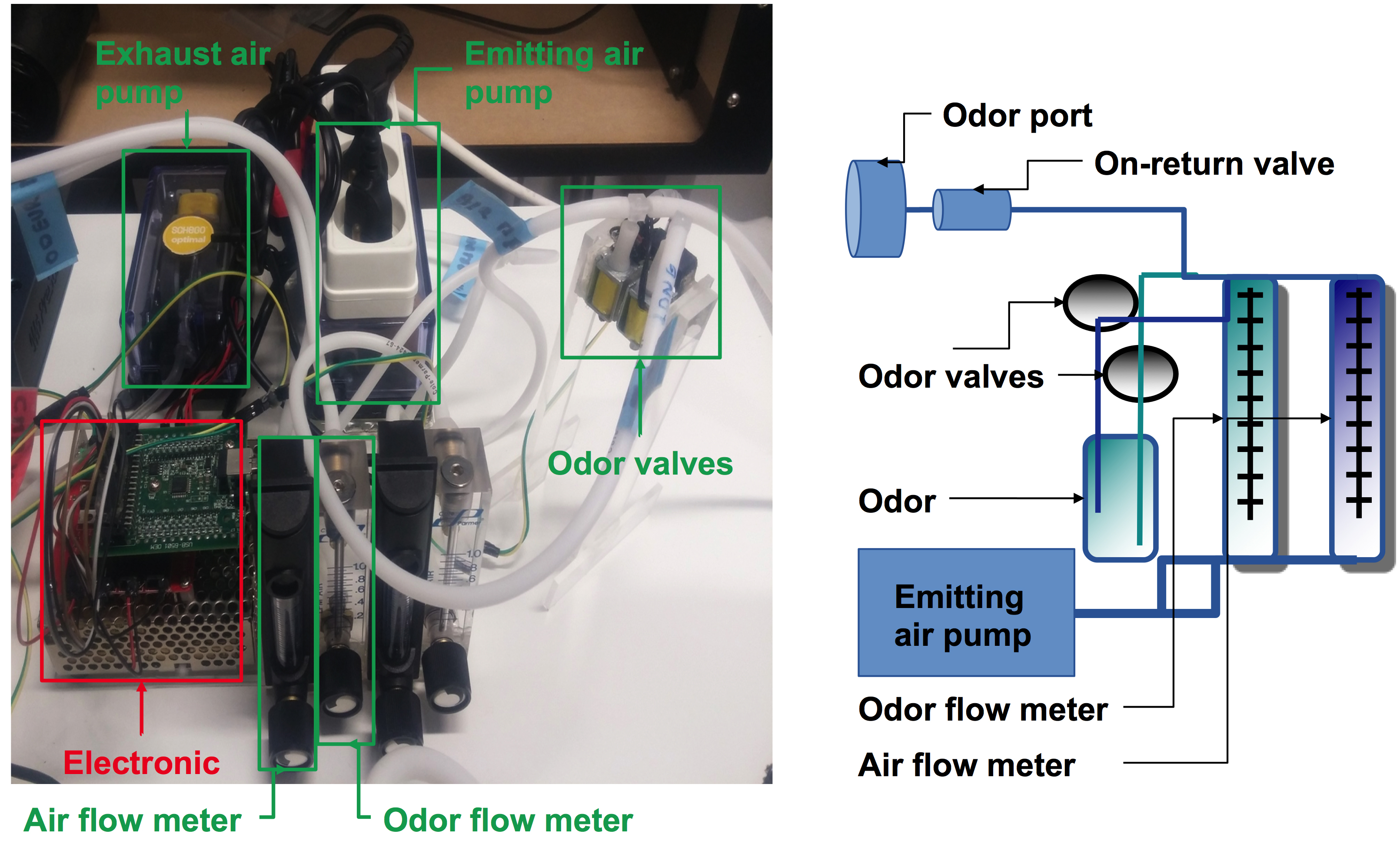
Figure 3. The odor dispenser. The odor dispenser distributes the Odor/Air mixture in a controlled manner. The air from the emitting air pump is transferred to the air flow meter and the odor flow meter. This device allows one to adjust the Odor/Air ratio (0.3 L/min for odorant and 2 L/min for air). If odor valves (can be “ASCO”, “Bio-Chem Fluidics” or equivalent normally closed solenoid pinch valves) are closed, then clean air will be diffused into the chamber, otherwise the odor will be diffused homogeneously in the chamber. The air is evacuated into the isolated chamber by the exhaust air pump at a flow rate of 1.5 L/min. C-Flex® Standard Tubing (ID: 0.125 OD: 0.250) is used to connect the different devices.
Software
- The software (Figure 4):
Pups emitted ultrasonic vocalizations at 40-120 kHz that were detected using an ultrasonic microphone connected to a bat detector (frequency range 10-130 kHz) that converts ultrasonic sounds to the audible frequency range. Using the broadband 60 kHz output of the detector, ultrasonic calls were sampled, recorded and analyzed using Audacity open software (www.audacityteam.org).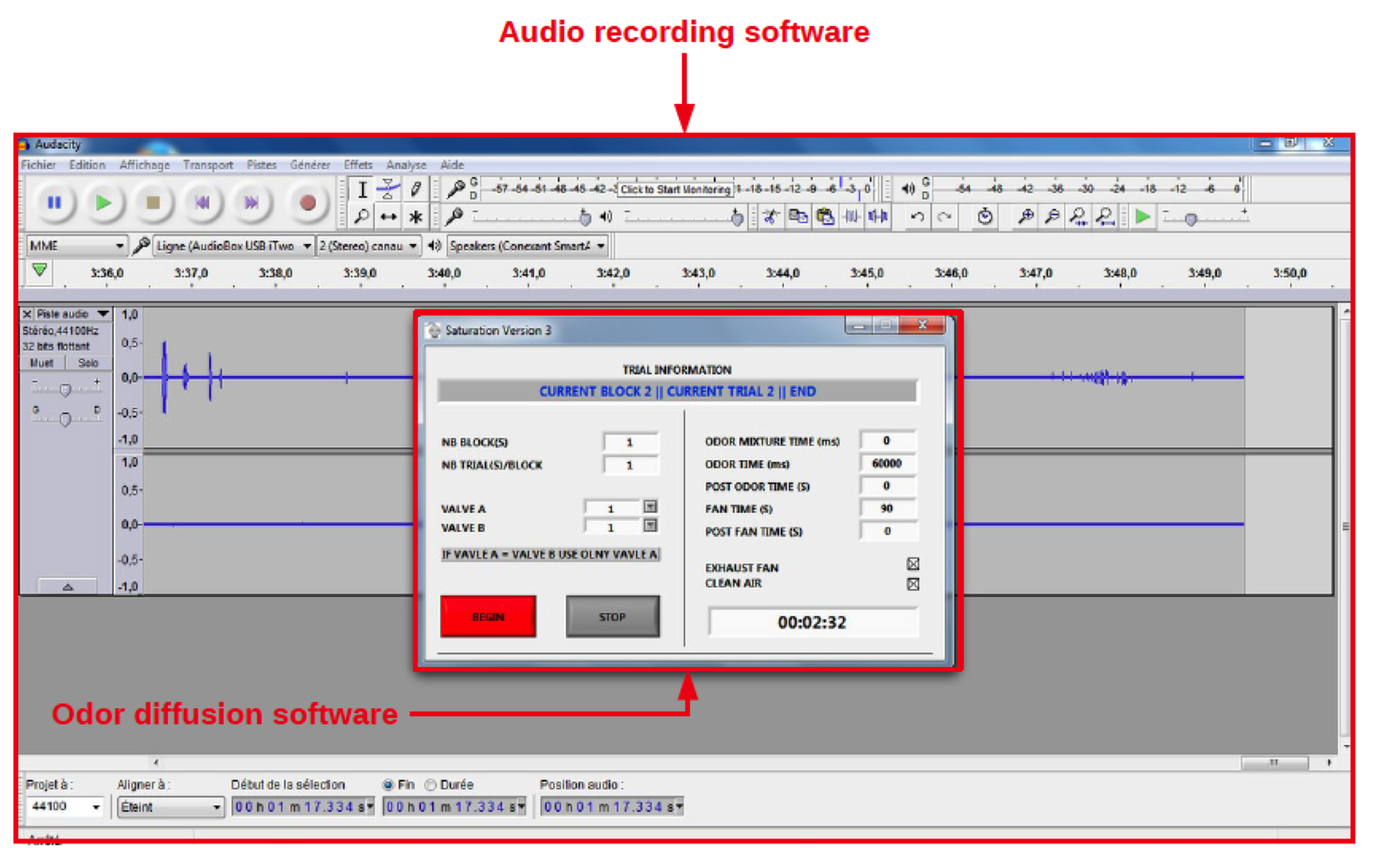
Figure 4. The audio recording software. This figure shows the computer screen with the open images of the audio recording and the odor diffusion software. The control of the diffusion of odors is ensured by a custom-made software. This software can be replaced by the Node-RED software coupled with an Arduino. As the Arduino appears as a Serial device, the Serial in/out nodes can be used to communicate with it (https://nodered.org/docs/hardware/arduino). - GraphPad Prism software (GraphPad Software, USA) is used for data analysis
Procedure
文章信息
版权信息
© 2019 The Authors; exclusive licensee Bio-protocol LLC.
如何引用
Readers should cite both the Bio-protocol article and the original research article where this protocol was used:
- Wagner, S., Lledo, P. and Lazarini, F. (2019). Assessing Olfaction Using Ultrasonic Vocalization Recordings in Mouse Pups with a Sono-olfactometer. Bio-protocol 9(4): e3170. DOI: 10.21769/BioProtoc.3170.
- Lazarini, F., Katsimpardi, L., Levivien, S., Wagner, S., Gressens, P., Teissier, N. and Lledo, P. M. (2018). Congenital cytomegalovirus infection alters olfaction prior to hearing deterioration in mice. J Neurosci 38(49): 10424-10437.
分类
神经科学 > 感觉和运动系统 > 动物模型
神经科学 > 神经系统疾病 > 动物模型
您对这篇实验方法有问题吗?
在此处发布您的问题,我们将邀请本文作者来回答。同时,我们会将您的问题发布到Bio-protocol Exchange,以便寻求社区成员的帮助。
Share
Bluesky
X
Copy link


